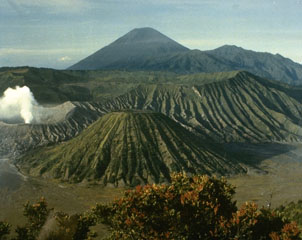Report on Tengger Caldera (Indonesia) — June 1980
Scientific Event Alert Network Bulletin, vol. 5, no. 6 (June 1980)
Managing Editor: David Squires.
Tengger Caldera (Indonesia) Large incandescent tephra to 1.5 km away
Please cite this report as:
Global Volcanism Program, 1980. Report on Tengger Caldera (Indonesia) (Squires, D., ed.). Scientific Event Alert Network Bulletin, 5:6. Smithsonian Institution. https://doi.org/10.5479/si.GVP.SEAN198006-263310
Tengger Caldera
Indonesia
7.942°S, 112.95°E; summit elev. 2329 m
All times are local (unless otherwise noted)
Vapor emission from Bromo cone . . . began 2 June. Several days later, Bromo started to eject incandescent tephra. Glowing bombs 1 m in diameter fell as much as 400 m from the crater rim, while ash-laden vapor rose 600-800 m, accompanied by rumbling. Crowds of tourists approached to within 500 m of the vent during the first two weeks of the eruption.Activity intensified during the 3rd week, with explosions every few seconds to two minutes. By 21 June, some cauliflower-shaped ash clouds rose 900 m. VSI moved tourists away from the immediate vicinity of the eruption to the caldera rim, where a resort hotel is located ~4 km from Bromo.
By 24 June, explosive episodes, accompanied by loud detonations, had become more vigorous but less frequent, occurring at 4-5 minute intervals. Although about half of the ejecta fell back into the crater, 1-m-diameter bombs set bushes afire at the foot of Batok cone, 1.5 km away.
Geological Summary. The 16-km-wide Tengger caldera is located at the northern end of a volcanic massif extending from Semeru volcano. The massive volcanic complex dates back to about 820,000 years ago and consists of five overlapping stratovolcanoes, each truncated by a caldera. Lava domes, pyroclastic cones, and a maar occupy the flanks of the massif. The Ngadisari caldera at the NE end of the complex formed about 150,000 years ago and is now drained through the Sapikerep valley. The most recent of the calderas is the 9 x 10 km wide Sandsea caldera at the SW end of the complex, which formed incrementally during the late Pleistocene and early Holocene. An overlapping cluster of post-caldera cones was constructed on the floor of the Sandsea caldera within the past several thousand years. The youngest of these is Bromo, one of Java's most active and most frequently visited volcanoes.
Information Contacts: A. Sudradjat, L. Pardyanto, and Suparban, VSI.

